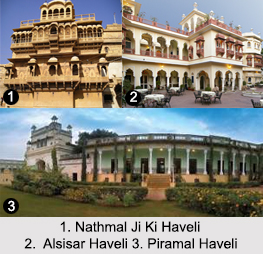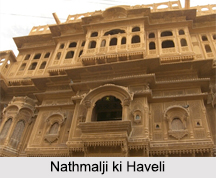 Havelis in Rajasthan bring the charisma and splendour of the long-gone Rajput period. Havelis in Rajasthan once belonged to the previous rulers, wealthy merchants and jagirdars which depict the cultural heritage of Rajasthan. The term Haveli denotes a private residence of Rajasthan. The Persian origin of this word means "an enclosed place."
Havelis in Rajasthan bring the charisma and splendour of the long-gone Rajput period. Havelis in Rajasthan once belonged to the previous rulers, wealthy merchants and jagirdars which depict the cultural heritage of Rajasthan. The term Haveli denotes a private residence of Rajasthan. The Persian origin of this word means "an enclosed place."
The havelis in Rajasthan are widely seen in the areas of Jaisalmer, Sekhawat region, Marwar and other districts where the traders used to dwell. Till date they are considered interesting pieces of Rajasthani art.
History of Havelis in Rajasthan
From 1830s Haveli became an important building in Rajasthani regions of Shekhawati and Marwar. The marwaris used to commission artists to paint the havelis. These were a status symbol for the merchants and traders. These were also the dwelling places of the joint families that offered comfort away from the day-to-day tensions of the world. There would be one large gate at the entrance and the mansion would be closed from the other sides. These were spacious abodes that were richly decorated.
Features of Havelis in Rajasthan
 The main features of these havelis were chhajjas (sunshades), jharokhas (balcony windows) and jalis (screen windows). These huge mansions were usually built around a courtyard with darwazas done in beautiful architectural elements. The marwari havelis of the Shekhawati region have murals with remarkable colours. The motifs on the walls are varied from everyday scenes and subjects inspired by the west. An amazing feature of these havelis was the intricately carved wooden doors.
The main features of these havelis were chhajjas (sunshades), jharokhas (balcony windows) and jalis (screen windows). These huge mansions were usually built around a courtyard with darwazas done in beautiful architectural elements. The marwari havelis of the Shekhawati region have murals with remarkable colours. The motifs on the walls are varied from everyday scenes and subjects inspired by the west. An amazing feature of these havelis was the intricately carved wooden doors.
Architecture of Havelis in Rajasthan
The havelis of Shekhawati consist of 2 courtyards - an outer one and an inner one. The outer courtyard is for men. The inner courtyard (aangan) is exclusively for women. A large Haveli with two or three stores can have three to four courtyards. The towns and villages of Shekhawati are renowned for the frescos on the walls. One of the most well known Haveli in this regard is the Patwa havelis of Jaisalmer. The stone carved jharokhas are a major tourist attraction here.
Other places where one can come across grandiose havelis are Churu, Jhunjhunu and Sikar. The havelis were mainly painted in blue, yellow, green, indigo and maroon. With the advent of the 19th century the motifs on the walls underwent a change. New themes of telephones, trains, cars, balloons, British hunters, gramophones, the paintings of the Haveli owners became popular.
Famous Havelis in Rajasthan
From Jaipur to Jaisalmer and from Bikaner to Jodhpur, the colourful Havelis in Rajasthan tell again the magnificence and splendour of the former times. Tourists often plan their tour to Rajasthan to get a sight of these Havelis in Rajasthan. Following are the famous Havelis in Rajasthan:
Haveli of Seth Arjun Das Goenka: It is situated at Jhunjhunu district`s small town Dundlod. It is an architectural wonder showcasing the life of the merchant clans of the area. The haveli is detached into two different quarters, the mardana or male quarter and zenana or the inner female quarters.
Patwon ki Haveli: Patwon ki Haveli is a compound of five havelis built side by side. The compound was constructed by Guman Chand Patwa who was a famous dealer of textile and precious metals. The metaphorical paintings on yellow sandstone adjoin to the splendour of this bunch of havelis.
 Nathmal Ji Ki Haveli: This haveli served as the dwelling of Diwan Mohata Nathmal, the former Prime Minister of Jaisalmer. It was commissioned to be built in 1885 by Maharawal Bairisal.
Nathmal Ji Ki Haveli: This haveli served as the dwelling of Diwan Mohata Nathmal, the former Prime Minister of Jaisalmer. It was commissioned to be built in 1885 by Maharawal Bairisal.
Samode Haveli: Rawal Sheo Singh built the Samode Haveli around 175 years ago. This inherited mansion was turned into a boutique hotel in 1988 and was opened for guests to travel around the luxurious artwork showcased in every corner of the haveli.
Piramal Haveli: It was built in 1924 by Seth Piramal Chaturbhuj Makhania. This Rajasthani haveli showcases a modern approach to traditional architecture. Seth Piramal was a trader of silver, cotton and opium. The murals on the walls are symptomatic of the British influence on the lifestyle of the wealthy local merchants.
Bagore ki Haveli: It was built by Amir Chand Badwa, the then prime minister of Mewar in the 18th century. The haveli is situated at the harbour of Lake Pichola at Gangori Ghat and the splendid structure is composed of more than 100 rooms.
Alsisar Haveli: The Alsisar Haveli is located in the heart of the Jaipur city. The history of this haveli dates back to the 18th century. It highlights the splendour of old Rajput days and the regal of Rajasthani experience for the guests.
Mandawa Haveli: The Mandawa Haveli in Jaipur was built in the year 1896 by Thakur Bhagwat Singhji, the 15th ruler of Mandawa. The Haveli was built in Jaipur style of architecture with many pillars and arches and is luxuriantly curved.
Salim Singh ki Haveli: Salim Ji ki Haveli is situated at the heart of the Jaisalmer city, near the Jaisalmer railway station. This Haveli is 300 years old Haveli and is named after its owner Salim Singh Mahto. Salim Singh Mahto was the then prime minister of the princely state with Jaisalmer as its capital.






